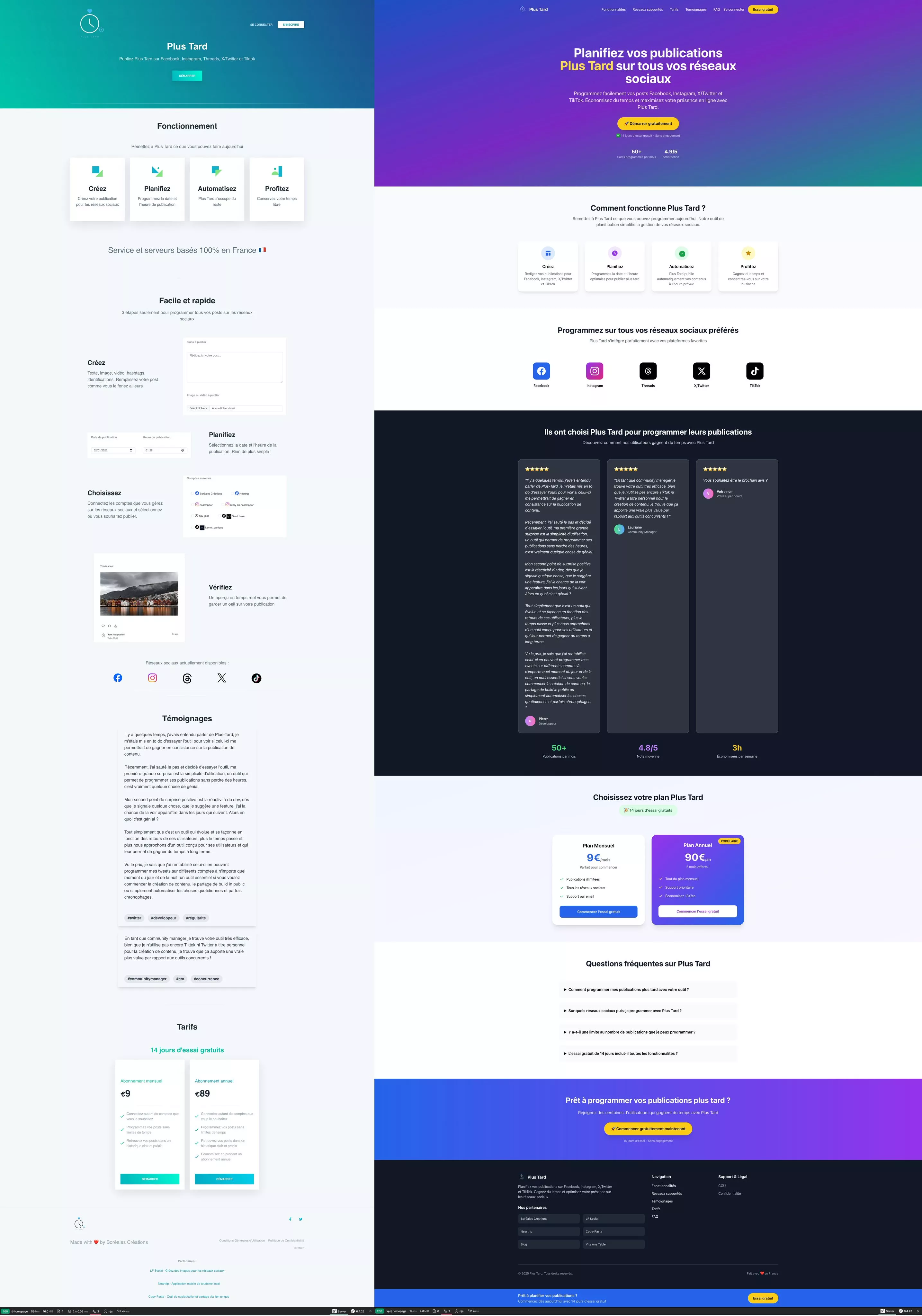
Using AI to redesign your website or application's design
Free services
Integrate maps to your sites Editable QR Code after printing Customizable short link Password generator Create images for social networks Create harmonious color palettes Unminify your code Create .gitignore files with ease Restaurant reservation system Booking software for hairdressersWell, that's all well and good, but it's back-to-school time! So while most people are shopping for school supplies and buying new colorful backpacks, what are we doing in dev?
Well, for starters, we can begin by doing a little recap of what happened during the summer.
As often happens, it's the perfect time to rest and try new things. In my case, the major test was to push AI a bit further than usual to see what it could bring me.
So let's go, I'll tell you all about it! 😀
The Starting Project
As you probably already know, I created some time ago a micro-SaaS called href="https://plus-tard.com" target="_blank">Plus Tard whose goal is to schedule social media posts in advance.
I started coding this tool in early 2024, which is an eternity in the dev world, especially for AI.
In the meantime, many things have happened and the first paying customers arrived with their feedback. The focus therefore had to be on the interface AND user experience, meaning UI/UX.
First, on the outside of the app, on the landing page, to attract people and convert as much as possible by making them want to sign up and use the tool.
Then obviously on the inside, for users who have already taken the plunge with a subscription and who use the tool full-time.
Two major areas to improve, and if possible before the back-to-school season and before social media buzz picks up again.
The Role of AI
In 2025, every good dev must think about AI and understand how it can save them time. That's why I thought from the start about placing it in this redesign process.
Yes, but not just any way. Because contrary to what one might think, AI is still far from replacing a developer. For one simple reason: analysis.
You have to think about SEO, UX, adequate UI elements, coordinated colors, etc.
Without precise directives, AI will do "as it pleases" and the result will be uninteresting. Of course, it will always be possible to iterate and ask for touch-ups here and there. But then you mustn't fall into the trap of ultimately taking more time iterating than the redesign would have taken without AI.
Directive Coding
Giving instructions to the AI being used is therefore essential and it's the work to be done upstream before launching anything.
For my part, and for this project, I listed what I had in mind, what I wanted to keep or conversely change, and all the obligations to meet.
Here's an example of part of the listing:
- Integration of TailwindCSS and use of its classes
- Keep the dominant blue/green colors and gradient effects
- Highlight the service's added value (headers, catchphrases, CTAs...)
- Emphasize both SEO and UX (detailing for this point which elements are most important to consider)
The second important part is to break the project into several parts as you would before giving tasks to real developers.
Here, I first started with the landing page before redesigning the app itself, because there are fewer user interactions, fewer elements, and more room to maneuver for adding new things.
After a few iterations, the result already looked like something decent and quite pleasing to the eye. Here's a final before/after, but visually quite close to what was initially produced so you can get an idea.
The Positive Points ✅
- Speed, obviously. AI has this ability to output code, even simple HTML/CSS, very quickly and a complete redesign can take 40 to 50% less time than the norm.
- Relatively clean code thanks to the initial prompt and also to Tailwind integration. With classes and components already predefined, AI can easily document itself and build something coherent.
- Relevant color schemes. I wouldn't have thought this part would be best handled by AI, as it's often said that it doesn't "see" and can only rely on text and code itself. But the fact is that the result is visually pleasing.
The Negative Points ❌
- JavaScript. In this case, this project uses a lot of Stimulus and Symfony UX. These are parts that AI couldn't handle. Either it completely forgot them, or they were no longer functional because the HTML code was no longer adapted to what needed to happen on the controller side.
- SEO. Despite precise instructions on SEO, it also failed to sufficiently fill the pages to maximize SEO and even less able to position the site on interesting niches.
Conclusion
To conclude, we can say that yes, AI saves a ton of time on very long tasks, yes, AI is a good assistant for establishing a work plan for a redesign.
No, it doesn't have sufficient analytical capacity, yes, you have to go back over it on many points, but with a well-framed prompt, these remain details and don't prevent time savings.
If you want to visit the final version (or test the "Plus Tard" SaaS), it's right here.
As for me, see you next time on another equally exciting topic 😀



